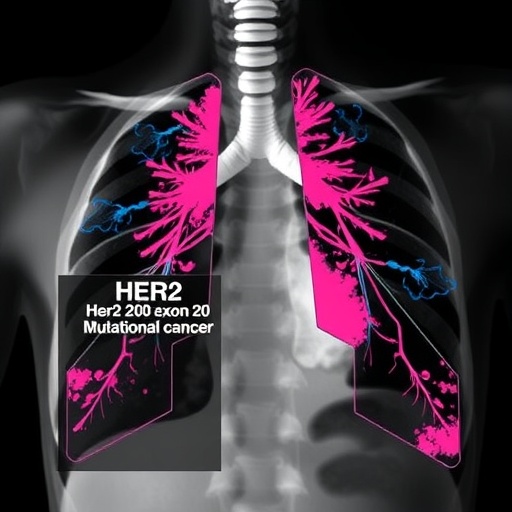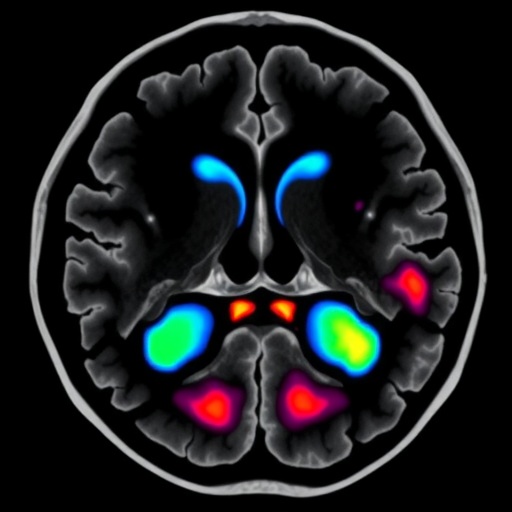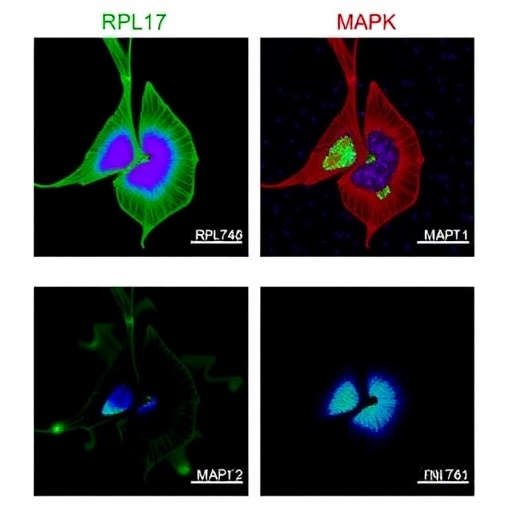
In the relentless quest to untangle the complex genomic landscape of non-small cell lung cancer (NSCLC), a groundbreaking multicenter investigation conducted in South China has shed critical light on the oncogenic variants of the HER2 gene, specifically focusing on mutations within exon 20. This pioneering study, published in BMC Cancer, delves deep into the molecular underpinnings and clinical ramifications of HER2 exon 20 mutations, a subset of alterations that have long intrigued oncologists due to their elusive role in tumor progression and therapeutic resistance.
Lung cancer remains the leading cause of cancer-related mortality worldwide, with NSCLC representing the vast majority of cases. Among its diverse genetic drivers, alterations in the HER2 (human epidermal growth factor receptor 2) gene have emerged as pivotal players influencing tumor behavior and patient prognosis. HER2 exon 20 mutations, however, constitute a particularly challenging molecular alteration, often associated with aggressive disease phenotypes and poor outcomes. The recent study rigorously analyzed 651 NSCLC patients, identifying 51 individuals harboring HER2 mutations and spotlighting 20 patients with explicit exon 20 alterations.
The researchers employed next-generation sequencing (NGS) technology to detect HER2 mutations across multiple biological matrices, including tumor tissue, plasma, cerebrospinal fluid, and pleural effusion. This comprehensive approach ensured high sensitivity in mutation detection, accounting for tumor heterogeneity and the dynamic nature of circulating tumor DNA. The study further stratified patients into those possessing exon 20 mutations versus other HER2 mutations and distinguished between treatment-naïve (baseline) and previously treated (non-baseline) groups, lending nuanced insight into mutation prevalence and clinical behavior.
One of the study’s most striking revelations pertained to the demographic and clinical profiles associated with exon 20 mutations. Patients with these variants were predominantly male and more frequently found in the non-baseline group, indicative of a possible enrichment after prior treatments. Notably, adenocarcinoma was the dominant histological subtype across all HER2-mutant patients, aligning with previous reports that link HER2 alterations primarily to this histology. Furthermore, stage IV disease predominated, underscoring the aggressive clinical course in affected individuals.
Metastatic patterns unveiled a predilection for pulmonary and nodal dissemination among exon 20 mutation carriers. The lungs and lymph nodes emerged as the foremost metastatic sites, with brain involvement also significantly observed. These metastatic tendencies highlight the invasiveness of exon 20 mutant tumors and suggest a distinct metastatic cascade compared to other HER2 aberrations or NSCLC subsets. Such insight could impact surveillance strategies and therapeutic targeting in clinical practice.
Genomic characterization revealed that exon 20 mutations were overwhelmingly represented by in-frame insertions and deletions (indels), accounting for 92% of alterations. The most recurrent mutation identified was the p.Y772_A775dup variant, constituting 70% of exon 20 indels. These structural changes in the HER2 protein are hypothesized to induce aberrant kinase activation, driving oncogenic signaling and conferring proliferative advantage to tumor cells.
The molecular consequences of HER2 exon 20 indels were further elucidated through Gene Ontology (GO) analyses. This bioinformatics interrogation unraveled a connection between these mutations and dysregulated protein kinase activity, a hallmark of many oncogenic pathways. Additionally, the study linked exon 20 mutants to alterations in anoikis, a form of programmed cell death triggered by detachment from the extracellular matrix. Resistance to anoikis is a key facilitator of metastasis, enabling cancer cells to survive during dissemination and colonization of distant organs.
Clinically, the prognostic implications of exon 20 mutations were profound. Patients harboring these mutations exhibited significantly inferior overall survival compared to those with non-exon 20 HER2 mutations. This survival disparity persisted despite comparable distributions in age, smoking history, and TNM staging, emphasizing the independent adverse impact of exon 20 variants. This finding elevates the clinical urgency to develop effective targeted therapies that can overcome the intrinsic resistance mechanisms conferred by these mutations.
The study’s comprehensive design also allowed for evaluation of progression-free survival (PFS) and treatment responses, albeit specific therapeutic outcomes were not deeply dissected in the published report. Future research building on this dataset may elucidate how exon 20 mutations modulate responses to existing anti-HER2 agents and investigate novel therapeutic modalities tailored to this subgroup, potentially including irreversible kinase inhibitors, antibody-drug conjugates, or combination regimens.
This research underscores the imperative for robust molecular profiling in NSCLC, especially in regions like South China where comprehensive genomic data remain limited. The identification and characterization of distinct HER2 exon 20 mutations in this cohort illuminate baseline mutation prevalence and biologic behavior, equipping clinicians with crucial knowledge to refine diagnosis, prognostication, and personalized treatment strategies.
Moreover, the study’s findings stimulate ongoing discussions regarding the development of targeted therapies. Existing HER2 inhibitors, primarily designed for breast cancer, often exhibit limited efficacy against NSCLC exon 20 insertions, necessitating drug design innovations that accommodate the unique structural and signaling alterations these mutations provoke. Drug resistance mechanisms linked to altered kinase conformations or bypass pathway activation further complicate treatment landscapes but offer fertile ground for translational research.
Notably, the association of exon 20 insertions with increased metastatic burden and resistance phenomena sheds light on cancer evolution dynamics under therapeutic pressure. The enrichment of these mutations in non-baseline patients suggests selective expansion of resistant clones following systemic treatments, reinforcing the need for early molecular intervention and adaptive therapeutic regimens.
Beyond immediate clinical ramifications, this investigation advances our foundational understanding of HER2-driven lung oncogenesis. By integrating genomic, clinical, and bioinformatic data, the study charts a pathway toward deciphering complex oncogenic networks and their phenotypic manifestations, fostering a precision oncology paradigm that transcends histological boundaries.
In conclusion, this multicenter study from South China delivers unprecedented insights into the clinical and genomic landscape of HER2 exon 20 mutations in NSCLC. It delineates the mutation spectrum, associated metastatic tendencies, and adverse prognostic impact, anchoring these findings within a comprehensive molecular framework. As the oncology community intensifies efforts to surmount therapeutic resistance and improve patient outcomes, such seminal work propels the field toward novel precision medicine strategies tailored to this challenging genomic subset.
Harnessing these insights, future research and clinical trials must prioritize the design and testing of innovative targeted agents and combination approaches to nullify the biological advantages conferred by HER2 exon 20 mutations. Through concerted global collaboration and translational vigor, overcoming the formidable hurdle of HER2 exon 20 variant-driven NSCLC holds promise as the next frontier in lung cancer therapeutics.
—
Subject of Research: Genomic and clinical profiling of HER2 exon 20 mutations in non-small cell lung cancer.
Article Title: Genomic and clinical characterization of HER2 exon 20 mutations in non-small cell lung cancer: insights from a multicenter study in South China
Article References:
Hou, Y., Xue, X., Zhang, Z. et al. Genomic and clinical characterization of HER2 exon 20 mutations in non-small cell lung cancer: insights from a multicenter study in South China. BMC Cancer 25, 752 (2025). https://doi.org/10.1186/s12885-025-14125-9
Image Credits: Scienmag.com
DOI: https://doi.org/10.1186/s12885-025-14125-9
Tags: aggressive disease phenotypes in NSCLCclinical implications of HER2 mutationsgenomic landscape of lung cancerHER2 exon 20 mutationslung cancer mortality statisticsmolecular underpinnings of lung cancernext-generation sequencing technologynon-small cell lung cancer researchoncogenic variants of HER2 geneSouth China multicenter investigationtherapeutic resistance in lung cancertumor progression in lung cancer





